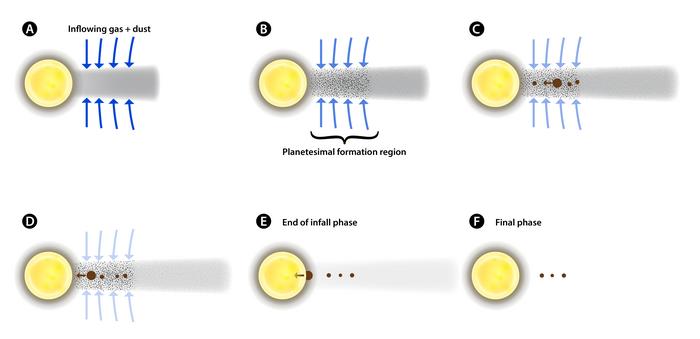In a groundbreaking study from the Southwest Research Institute (SwRI), scientists have proposed a revolutionary model for understanding the formation of compact exoplanetary systems, which are characterized by multiple rocky planets in close orbits around their parent star. This innovative approach contrasts starkly with traditional views of planet and star formation, which often treat the two processes as sequential and entirely distinct. The findings, which have been detailed in a recent issue of Nature Communications, challenge long-standing assumptions in the field of astrophysics and could provide critical insights into the dynamics of planet formation in the universe.
Traditionally, the prevailing theory has been that planets form after the initiation of stellar formation is complete. However, researchers Dr. Raluca Rufu and Dr. Robin Canup from SwRI have elucidated a scenario wherein planetary development begins concurrently with the closing phases of stellar creation. This is a pivotal shift in thinking, particularly as it opens new avenues for understanding why certain planetary systems, particularly compact ones, exhibit remarkably consistent mass ratios that differ significantly from our solar system.
The impetus behind this study arose from observations of numerous compact exoplanetary systems that possess several planets closely encompassing their host stars. These systems starkly contrast with solar system configurations wherein no planets orbit closer than Mercury. Intriguingly, existing data indicates that across various compact systems, the total planetary mass maintains a strikingly uniform ratio relative to the mass of the host star—an enigma that demands exploration.
Utilizing advanced computational simulations, Rufu and Canup successfully demonstrated that early-formed planets are capable of surviving the formative process. Notably, these simulations align with observable characteristics of compact systems, including tightly packed planetary orbits and their unusual mass ratios. The research further corroborates earlier findings from the Atacama Large Millimeter Array (ALMA) telescope, which suggested that observations of protoplanetary disks indicate that planetary formation might commence earlier than previously thought.
Rufu highlighted the significance of these results by stating, “Compact systems are one of the great mysteries of exoplanet science.” The research reveals that planets in such systems are akin to “peas-in-a-pod”—remarkably similar in size and mass, purposed with a common mass ratio that starkly contrasts with the diverse sizes of planets in our solar system. This resemblance to satellite systems around gas giants, which are thought to emerge as their parent planets complete formation, posits a compelling hypothesis that the processes governing the formation of compact planetary systems might share underlying mechanisms.
The study’s findings can be framed within the context of the lifecycle of stars, wherein a molecular cloud of gas and dust collapses under its own gravity to form a star. During this pivotal phase, material drawn towards the central mass is first integrated into a circumstellar disk. This disk is a crucial arena for the formation of planets, enduring several million years post-infall before its gas dissipates. Interestingly, the research proposes that the traditional perspective, which posits that planetary assembly begins post-infall, is likely oversimplified. Instead, the evidence compiled suggests that planetary accretion might initiate during the stellar infall phase.
According to the mathematical models constructed by the researchers, as infall occurs, evolving planets accumulate rocky material while their orbits experience a gradual inward migration. This dynamic interaction with surrounding disk gas fundamentally alters their paths, leading to accelerated inward movement as planets gather additional mass. Crucially, this interplay between planetary mass increase and orbital adjustment results in a destructive scenario where sufficiently massive planets may fall into the star itself, creating a balancing effect that typically yields planets of uniform size and mass.
The researchers assert that their results provide a robust explanation for the common mass ratios observed in multi-planet compact systems. The concept draws parallels to the formation of moons around gas giants, albeit with nuanced differences; while gas giant satellites form in quickly dispersing disks, protoplanetary disks persist significantly longer and permit a more gradual and substantial accretion of mass, resulting in lower mass ratios for compact planetary systems when compared to their gas giant counterparts.
In summary, this significant advancement in the understanding of exoplanet formation may not only resolve existing enigmas surrounding compact systems but also suggests that the processes of planetary assembly may operate on broader scales than previously assumed. It indeed presents an exciting proposition that the mechanisms of planetary formation across vastly different cosmic environments could share fundamental characteristics. This emerging model stands to reshape the landscape of exoplanet science by fostering new methods of inquiry into the nature of our universe and the processes that forge worlds around stars.
In closing, the revolutionary insights encouraged by this study from the Southwest Research Institute herald a new chapter for astrophysical inquiry, compelling scientists to reassess the intricacies of the birth of planets as they orbit their parent stars. The excitement spurred by the configurations of exoplanetary systems underscores a persistent curiosity that continues to drive research in this dynamic and ever-evolving field of study.
Subject of Research: Early formation of compact exoplanetary systems
Article Title: Origin of compact exoplanetary systems during disk infall
News Publication Date: 25-May-2025
Web References: https://doi.org/10.1038/s41467-025-60017-8
References: None listed
Image Credits: Credit: Southwest Research Institute
Keywords
Exoplanets, Compact Systems, Planet Formation, Stellar Formation, Protoplanetary Disks, Astrophysics, Computational Simulations, ALMA, Raluca Rufu, Robin Canup, Southwest Research Institute, Nature Communications.




